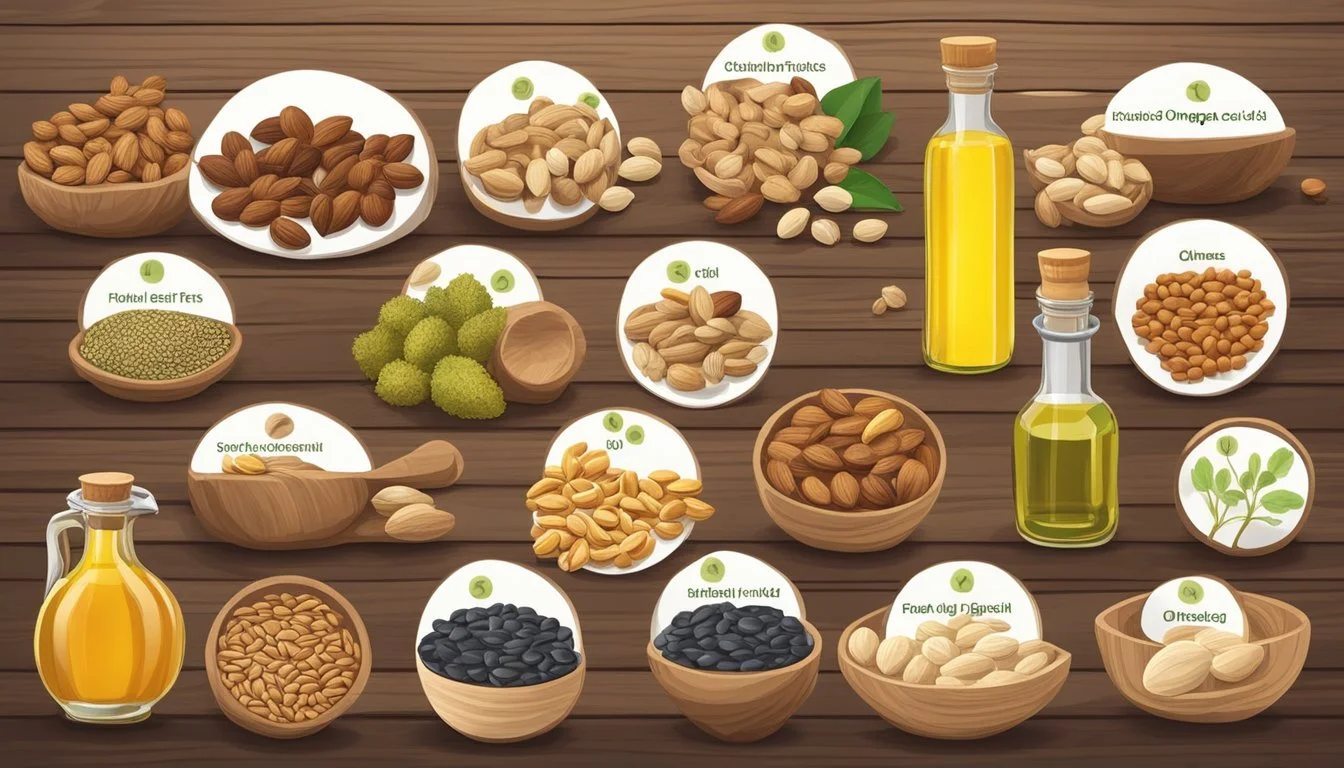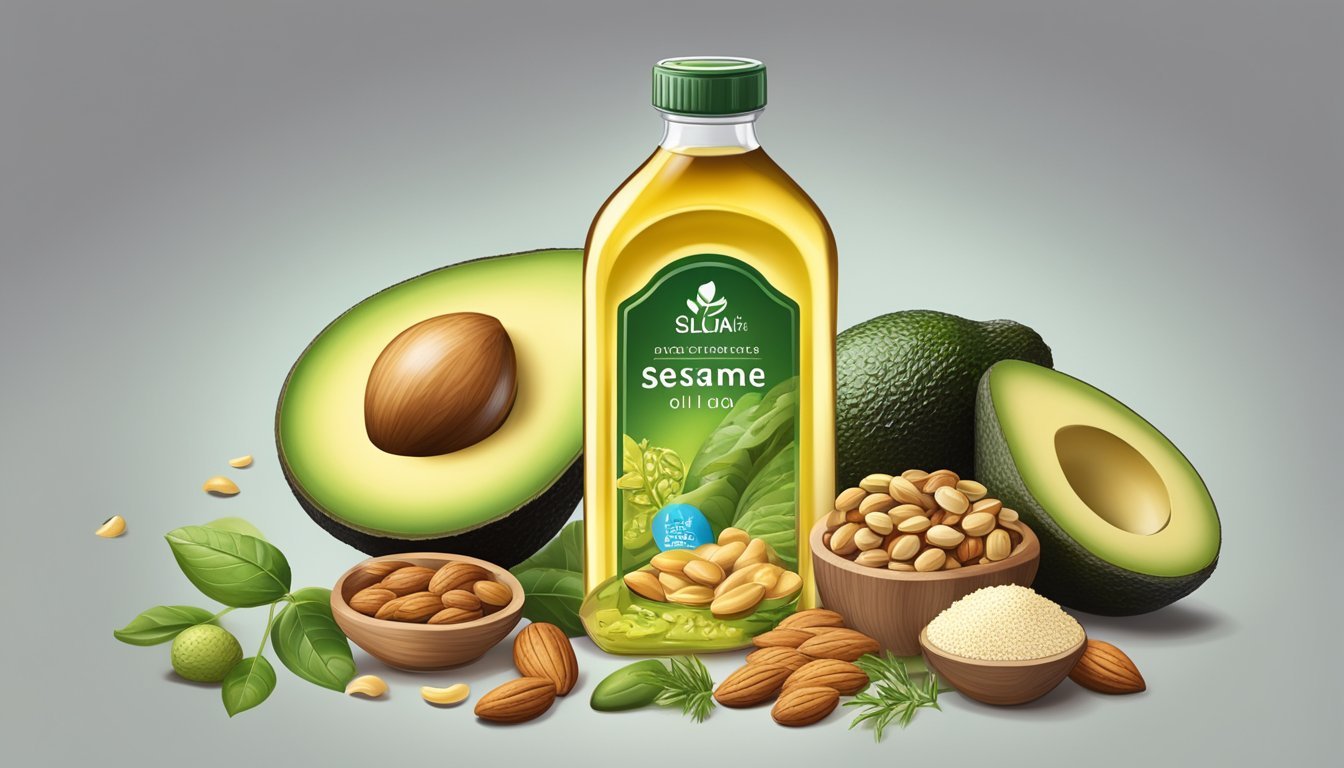Top Foods Rich in Omega-6 Fatty Acids
Essential Sources Explained
Omega-6 fatty acids are essential nutrients that play a critical role in brain function, as well as normal growth and development. These polyunsaturated fats must be obtained through the diet because the body cannot produce them on its own.
Many common foods are rich in omega-6 fatty acids, making it relatively easy to incorporate these important nutrients into a balanced diet. Understanding which foods are high in omega-6 can help individuals maintain a healthy ratio of fatty acids for optimal health.
1) Sunflower Oil
Sunflower oil is a well-known source of omega-6 fatty acids. Specifically, it contains about 8.9 grams of omega-6 per tablespoon, making it a significant contributor to dietary intake of these essential fats.
One of the reasons sunflower oil is popular is its versatility in cooking. It has a high smoke point, which makes it suitable for frying, sautéing, and baking.
In addition to its omega-6 content, sunflower oil is also rich in vitamin E, an antioxidant that helps protect cells from damage. This characteristic makes it a valuable addition to any balanced diet.
Despite its benefits, it's important to balance the intake of omega-6 with omega-3 fatty acids to ensure a healthy diet. This can help maintain the proper balance of fatty acids in the body, promoting overall health.
2) Corn Oil
Corn oil is a common source of omega-6 fatty acids.
It is widely used in cooking and food production.
This oil is extracted from the germ of corn kernels.
Corn oil contains primarily linoleic acid, an essential omega-6 fatty acid.
Linoleic acid is crucial for maintaining the health of skin and cell membranes.
Additionally, corn oil is often used in salad dressings, mayonnaise, and margarine.
Corn oil's high smoke point makes it suitable for frying and baking.
This characteristic allows for versatile culinary uses.
Despite its benefits, consumption should be balanced with omega-3 intake.
An imbalance in omega-6 and omega-3 ratios can lead to inflammation.
Therefore, it is important to consume corn oil in moderation.
3) Soybean Oil
Soybean oil is one of the most common sources of omega-6 fatty acids, widely used in cooking and food preparation. It contains a significant amount of linoleic acid, an essential fatty acid that contributes to various bodily functions.
This oil is extracted from soybeans and is prominent in many processed foods. It is often used for frying, baking, and as an ingredient in salad dressings due to its neutral flavor.
Soybean oil is also valued for its nutritional profile. Besides omega-6 fatty acids, it contains vitamin E and small amounts of omega-3s. This balanced composition makes it a beneficial addition to a diet when used in moderation. Numerous studies suggest that moderate consumption of omega-6s can support cardiovascular health.
4) Peanut Oil
Peanut oil, extracted from peanuts, is a significant source of omega-6 fatty acids.
It is commonly used in cooking due to its high smoke point, making it ideal for frying and sautéing.
One tablespoon of peanut oil contains approximately 4,321 mg of omega-6 fatty acids.
In addition to its omega-6 content, peanut oil is rich in monounsaturated fats, which are beneficial for heart health.
Its mild flavor makes it versatile, suitable for both savory and sweet dishes.
Peanut oil also contains vitamin E, an antioxidant that protects cells from damage.
Including peanut oil in moderation can help balance fatty acid intake.
5) Sesame Oil
Sesame oil is a prominent source of omega-6 fatty acids. A single tablespoon provides around 5,576 mg of omega-6, making it a valuable addition to diets seeking these fatty acids.
The oil is derived from sesame seeds, which contain both monounsaturated and polyunsaturated fats. It is notably rich in omega-6, contributing to heart health by supporting healthy cholesterol levels.
Sesame oil also includes minor amounts of omega-3 fatty acids. Despite this, its primary benefit comes from its high omega-6 content.
Incorporating sesame oil into meals can be simple. It is often used in cooking or as a salad dressing, adding a nutty flavor to dishes. Given its caloric density, it's recommended to use in moderation to avoid excess calorie intake.
Not only is sesame oil a versatile culinary ingredient, but it also provides significant health benefits through its omega-6 fatty acid content.
6) Almonds
Almonds are a nutritious and popular nut known for their impressive health benefits. They are a good source of omega-6 fatty acids, providing approximately 3.5 grams per ounce (about 23 almonds).
Almonds offer more than just omega-6s. They are rich in vitamin E, magnesium, and fiber, making them an excellent addition to a balanced diet.
These nuts can be enjoyed in various forms, such as raw, roasted, or as almond butter. Incorporating almonds into your diet can help you maintain a healthy balance of fatty acids.
Almonds are also known for their potential to support heart health. They contain monounsaturated fats, which can help improve cholesterol levels and reduce the risk of heart disease.
Almonds are versatile and can be added to salads, smoothies, or eaten as a snack. Their mild flavor and crunchy texture make them a favorite among many health-conscious individuals.
7) Walnuts
Walnuts are a popular type of tree nut known for their nutritional value. These nuts are high in omega-6 fatty acids, with a notable content of linoleic acid per serving.
Rich in essential nutrients, walnuts offer more than just omega-6 fatty acids. They also contain omega-3 fatty acids, making them a balanced choice for promoting heart health.
In addition to their fatty acid profile, walnuts are high in antioxidants, vitamins, and minerals. They provide fiber, protein, and beneficial plant compounds, contributing to various health benefits.
Regular consumption of walnuts may support cardiovascular health and help in maintaining healthy cholesterol levels due to their healthy fat content. They can be easily incorporated into the diet through snacking or as an ingredient in meals.
8) Pine Nuts
Pine nuts are a notable source of omega-6 fatty acids. These small, edible seeds come from pine trees, particularly species in the Pinus genus.
With a rich, buttery flavor, pine nuts are commonly used in various culinary dishes. They can be found in pesto, salads, and baked goods, enhancing both taste and nutritional value.
In addition to omega-6 fatty acids, pine nuts provide valuable nutrients like magnesium, protein, and vitamins E and K. These elements contribute to various health benefits, making pine nuts a desirable addition to a balanced diet.
Including pine nuts in meals can help increase the intake of essential polyunsaturated fats. Their convenient size and versatile use in recipes make them an easy way to boost nutritional content.
Pine nuts remain a delicious and nutrient-dense food option. Their omega-6 fatty acid content supports various bodily functions, and they can be enjoyed in a multitude of culinary applications.
9) Pumpkin Seeds
Pumpkin seeds are a nutrient-dense food that offers a variety of health benefits. These tiny seeds are rich in omega-6 fatty acids, making them a valuable addition to a balanced diet.
In addition to omega-6s, pumpkin seeds contain other important nutrients such as vitamin K, magnesium, and antioxidants. They can support heart health and help maintain proper bodily functions.
Incorporating pumpkin seeds into meals is simple. They can be eaten on their own as a snack, added to salads, or used in baking. Their versatility makes it easy to enjoy their benefits without much effort.
Pumpkin seeds also have diuretic properties. This can help the body expel excess fluids and salt, promoting overall health. These seeds are especially beneficial for those looking to enhance their nutrient intake with natural sources.
10) Brazil Nuts
Brazil nuts are a notable source of omega-6 fatty acids. These nuts are packed with nutrients, including heart-healthy polyunsaturated fats.
They also offer antioxidants, minerals, and fiber. These components can contribute to cardiovascular health by potentially lowering heart disease risk.
In addition, Brazil nuts contain linoleic acid, an essential omega-6 fatty acid. This nutrient plays a role in various bodily functions.
Much like other nuts and seeds, incorporating Brazil nuts into the diet should be done mindfully. Their rich nutrient profile makes them a valuable addition to a balanced diet.
Understanding Omega-6 Fatty Acids
Omega-6 fatty acids are a crucial part of a balanced diet, offering various health benefits while posing some risks if consumed excessively. This section delves into what omega-6 fatty acids are, their health benefits, and the potential risks of consuming too much.
What Are Omega-6 Fatty Acids?
Omega-6 fatty acids are polyunsaturated fats that are essential for human health. The body cannot produce these fats, so they must be obtained through diet. They play a significant role in brain function and normal growth and development.
Common sources of omega-6 fatty acids include vegetable oils (such as safflower, sunflower, and corn oils), nuts, seeds, and some animal products. Linoleic acid is the most prevalent omega-6 fatty acid and is often converted in the body to other omega-6 fats that have different functions.
Health Benefits of Omega-6
Omega-6 fatty acids offer multiple health benefits. They help reduce nerve pain, improve blood lipid profiles, and maintain bone health. Moreover, these fatty acids support metabolism and stimulate skin and hair growth.
Studies also indicate that omega-6 fatty acids may help reduce inflammation, which can be advantageous for conditions such as rheumatoid arthritis. They are vital for the healthy functioning of cells and tissues throughout the body. Consuming a balanced amount helps bolster the immune system and promote overall wellness.
Potential Risks of Excessive Omega-6 Intake
While beneficial in moderate amounts, excessive consumption of omega-6 fatty acids can lead to health issues. High intake may exacerbate inflammation, contributing to chronic diseases like heart disease, arthritis, and diabetes.
Balancing omega-6 with omega-3 fatty acids is crucial. A diet disproportionately high in omega-6s can offset this balance, negating some of the health benefits associated with omega-3s. Monitoring intake and maintaining a balanced diet helps mitigate these risks effectively.
Balancing Omega-6 and Omega-3
Achieving a proper balance of omega-6 and omega-3 fatty acids is crucial for maintaining overall health. These fats play different roles in the body, and their proportions can affect various bodily functions, including inflammation and cellular health.
Importance of Omega-6 to Omega-3 Ratio
A balanced ratio of omega-6 to omega-3 fatty acids helps reduce inflammation in the body. Pre-industrial populations typically had ratios ranging from 4:1 to 1:4, whereas modern diets often have much higher ratios. Excess omega-6 can lead to chronic diseases such as heart disease and arthritis.
Maintaining cellular health requires both types of fats. Omega-3s are known for supporting cardiovascular health, while omega-6s are essential but can cause adverse effects when consumed in excess. Combining both in ideal ratios ensures better health outcomes.
Tips for Maintaining Balance
Incorporate foods high in omega-3s like fish (salmon, tuna, cod), flax seeds, and leafy greens. Consuming these foods helps counteract the high levels of omega-6 found in processed foods and vegetable oils.
Use healthier cooking oils such as flaxseed oil or walnut oil instead of more common options like corn oil or sunflower oil, which are higher in omega-6. Experiment with diverse protein sources, including seafood and plant-based options, to balance your intake.
Reducing the consumption of processed snacks and fast food can help lower omega-6 intake. Production methods often use oils high in omega-6, further contributing to imbalance. Making conscious dietary choices is key to aligning with traditional, healthier fatty acid ratios.
Sources and Supplements
Omega-6 fatty acids can be obtained through various natural sources and supplements. The following sections detail the best sources of omega-6, supplement options, and dietary recommendations to ensure a balanced intake.
Natural Sources
Nuts and seeds are rich in omega-6 fatty acids. Walnuts, sunflower seeds, and sesame seeds are excellent choices, providing significant amounts of linoleic acid.
Vegetable oils like sunflower oil, soybean oil, and corn oil are also high in omega-6. They are commonly used in cooking and food preparation.
Meat and poultry can be sources of omega-6, especially when derived from animals fed grain-based diets.
Including a variety of these foods in your diet can help meet the body's omega-6 needs efficiently.
Supplement Options
For those who may not get enough omega-6 from their diet, supplements can be a practical option. Evening primrose oil, borage oil, and black currant seed oil are popular omega-6 supplements.
These supplements generally contain gamma-linolenic acid (GLA), a beneficial type of omega-6 fatty acid.
Capsules and soft gels make it easy to incorporate these oils into your daily routine.
It's essential to follow the recommended dosage on the packaging and consult with a healthcare provider to avoid excessive intake.
Dietary Recommendations
To maintain a healthy balance between omega-6 and omega-3 fatty acids, aim for a dietary ratio of 1:4 to 1:5. Excessive omega-6 intake can potentially lead to inflammation, so monitoring consumption is crucial.
Incorporating omega-3-rich foods like flaxseeds, chia seeds, and fatty fish can help achieve this balance.
Using a variety of oils and rotating between sources can prevent overconsumption of any single type of fatty acid.
Tailoring your diet to include both omega-6 and omega-3 can promote overall health and well-being.






